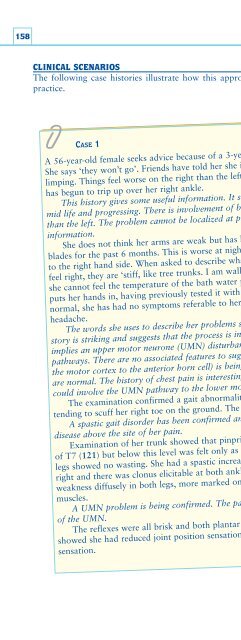You also want an ePaper? Increase the reach of your titles
YUMPU automatically turns print PDFs into web optimized ePapers that Google loves.
158CLINICAL SCENARIOSThe following case histories illustrate how this approach allows localization and diagnosis in neurologicalpractice.CASE 1A 56-year-old female seeks advice because of a 3-year slowly worsening problem with her legs.She says ‘they won’t go’. Friends have told her she is dragging her legs and looks as if she islimping. Things feel worse on the right than the left and she has decided to ask for help as shehas begun to trip up over her right ankle.This history gives some useful information. It sounds like an acquired disorder, coming on inmid life and progressing. There is involvement of both lower limbs, and the right is more affectedthan the left. The problem cannot be localized at present but further questioning reveals moreinformation.She does not think her arms are weak but has had some discomfort between her shoulderblades for the past 6 months. This is worse at night and feels like a band around her chest goingto the right hand side. When asked to describe what is wrong with her legs she says they don’tfeel right, they are ‘stiff, like tree trunks. I am walking like a robot’. Further questioning revealsshe cannot feel the temperature of the bath water properly; it feels suddenly very hot when sheputs her hands in, having previously tested it with her left foot. She is sure her upper limbs arenormal, she has had no symptoms referable to her cranial nerves, and there is no history ofheadache.The words she uses to describe her problems suggest an increase in muscle tone. The sensorystory is striking and suggests that the process is involving both motor and sensory systems. Thisimplies an upper motor neurone (UMN) disturbance and that the problem also affects sensorypathways. There are no associated features to suggest that the UMN pathway (the pathway fromthe motor cortex to the anterior horn cell) is being affected within the head, and the upper limbsare normal. The history of chest pain is interesting as a lesion in the thoracic cord at that levelcould involve the UMN pathway to the lower motor neurones as it traverses the thoracic cord.The examination confirmed a gait abnormality and she walked with a scissoring motion,tending to scuff her right toe on the ground. The cranial nerves and upper limbs were normal.A spastic gait disorder has been confirmed and no abnormalities have been found to implydisease above the site of her pain.Examination of her trunk showed that pinprick sensation was felt normally above the levelof T7 (121) but below this level was felt only as a prod on her left-hand side. Examination of herlegs showed no wasting. She had a spastic increase in tone more marked on the left than theright and there was clonus elicitable at both ankles, which was sustained on the right. She hadweakness diffusely in both legs, more marked on the right with relative sparing of antigravitymuscles.A UMN problem is being confirmed. The pattern of weakness is also typical of involvementof the UMN.The reflexes were all brisk and both plantar responses were extensor. Sensory examinationshowed she had reduced joint position sensation at the right great toe, with reduced vibrationsensation.(Continued on page 159)
















